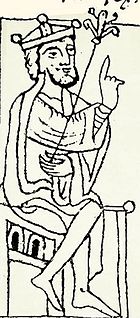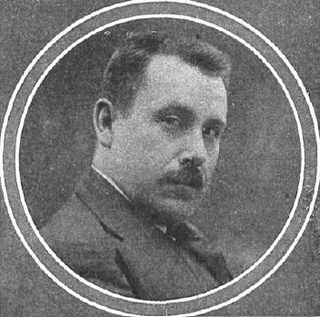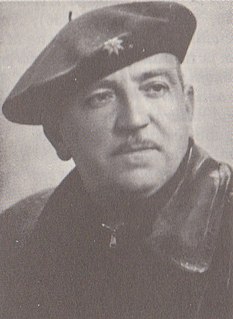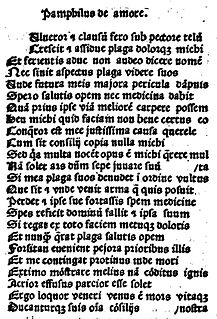
Aragonese is a Romance language spoken in several dialects by about 12,000 people as of 2011, in the Pyrenees valleys of Aragon, Spain, primarily in the comarcas of Somontano de Barbastro, Jacetania, Alto Gállego, Sobrarbe, and Ribagorza/Ribagorça. It is the only modern language which survived from medieval Navarro-Aragonese in a form distinctly different from Spanish.

Ramiro I was the first King of Aragon from 1035 until his death, although he is sometimes described as a petty king. He would expand the nascent Kingdom of Aragon through his acquisition of territories, such as Sobrarbe and Ribagorza, and the city of Sangüesa. Sancho Ramírez, his son and successor, was King of Aragon, but also became King of Pamplona.
Manuel Altolaguirre was a Spanish poet, an editor, publisher, and printer of poetry, and a member of the Generation of '27.

Manchones is a municipality in the province of Zaragoza, Aragon, Spain. According to the Spanish Statistical Institute (INE), the municipality had a population of 123 inhabitants in 2010. The pueblo is in the comarca of Campo de Daroca, about 6 kilometres (3.7 mi) northwest of Daroca and just southeast of Murero in the Calatayud-Daroca depression. The Jiloca River passes to the west.

Pablo Rabiella y Díez de Aux was a Spanish painter of battle-pieces and portraits.

Luis Rebolledo de Palafox y Melzi, 4th Marquess of Lazán, 9th Marquess of San Felices de Aragón was an Aragonese officer and general during the Spanish War of Independence. Alongside his brother José de Palafox, the Duke of Saragossa, Lazán was a national hero in 19th century Spain for his defence of Saragossa from the French Imperial armies in 1808 and 1809.

The Kingdom of Sobrarbe was the legendary predecessor to the Kingdom of Aragon and the modern region of Sobrarbe. According to the late medieval legend, the kingdom, with its capital at L'Aínsa, was a product of the Reconquista. The legend is based in part on the historical origins of the Kingdom of Pamplona.
Juan XiménezCerdán was a fiscal and constitutional lawyer and legal theorist who served as the Justicia Mayor of the Kingdom of Aragon from 1390 until 1423. He was a son of Domingo Ximénez Cerdán, also a Justicia, and María Sanz de Aliaga. He married María Pérez del Sou. In his capacity as Justicia he presided over the important Cortes of 1398 and 1412. When he was eighty years old, at the request of Martín Díez de Aux, Juan wrote a Carta or Letra intimada detailing the history of the office of the Justiciazgo. It was later published in the final edition of the Fueros y observancias de Aragón (1624) and was an important source for the legend of the Laws of Sobrarbe. Here is his description of how the office of Justicia arose:
Certain peoples conquered from the Moors a certain part of the kingdom in the mountains of Sobrarbe, and since these were communities with neither governor nor alderman, and given that there were many disputes and debates among them, it was determined that, to avoid such problems and so that they might live in peace, they should elect a king to reign over them ... but that there should be a Judge between them and the king, who would hold the title of Justicia of Aragon. It is held by some that the Justicia was elected before the king, and that the king was elected under such conditions. Since then there has always been a Justicia of Aragon in the kingdom, cognisant of all procedures regarding the king, as much in petitioning as in defence.

Gualberto Fabricio de Vagad was an Aragonese Cistercian Benedictine monk and the first historian of the Kingdom of Aragon. He was born in Zaragoza in the first third of the fifteenth century and straddles the line between the Late Middle Ages and the Renaissance. He lived most of his life at the monastery of Santa María de Santa Fe, though he also spent some time at San Juan de la Peña. According to Félix de Latassa y Ortín, besides history he wrote various treatises on poetry and a compendium of verse.
Francisco del Plano y García de la Cueva was a Spanish painter who was active in Navarra and the Basque Country.

Pablo Nassarre was a Spanish priest, organist, and Baroque composer. His work, Escuela Música según la práctica moderna, made him an important theorist of the Baroque era.

Pablo Luna Carné was a Spanish composer. His best-known composition is the aria "De España vengo" from the zarzuela El niño judío.

Jesús Comín y Sagüés was a Spanish Carlist politician and soldier. He has been twice elected deputy to the Republican Cortes. He is also recognized for his role during early days of the Civil War, when he decisively contributed to Nationalist seizure of Zaragoza and large part of Aragón.

Latas [pronunciation: 'la tas ] is a noble historic family infanzona Aragonese that was first documented as Latas or Lata in 1055 a.C. The family comes from the mountains of the primitive Kingdom of Aragon, in the northern half of the current Spanish province of Huesca.
De Aragoniae Regibus et eorum rebus gestis libri V is a chronicle written in Zaragoza in 1509 by Lucio Marineo Siculo documenting the feats of the kings of the Aragonese Renaissance. The chronicle was written in Latin and was later translated into Spanish by Juan de Molina. The Spanish edition was published in Valencia in 1524 under the title Crónica d'Aragón.

Roman villa of Camino de Albalate is a Roman site near Calanda, Teruel, Aragon, Spain.

Sancho Sánchez was an important magnate of the Kingdom of Aragon in the late 11th and early 12th centuries, during the reigns of Sancho Ramírez, Peter I and Alfonso I. He was governor of the important Navarrese tenancies of Erro, the castle of San Esteban de Deyo (1084), the capital city of Pamplona (1092), Aibar and Tafalla (1098) and Falces and Leguín (1112). In Aragon proper, he governed the important fortress of El Castellar overlooking Muslim Zaragoza from 1091 and the town of Ejea from 1113. He held the rank of count from 1085, before that he was a lord (senior).

Juan Planck was a fifteenth-century German cleric turned printer who became a founder of the printing business in Iberia.

Pablo Gonzalvo y Pérez was a Spanish painter who specialized in urban landscapes and what are sometimes referred to as interior portraits.
Narbona Dacal, aka Narbona D'Arcal was a Aragonese healer in the 15th century who was condemned and executed by the Inquisition in 1498 after accusations of practicing witchcraft.















